
views
Flooding the Ant Colony
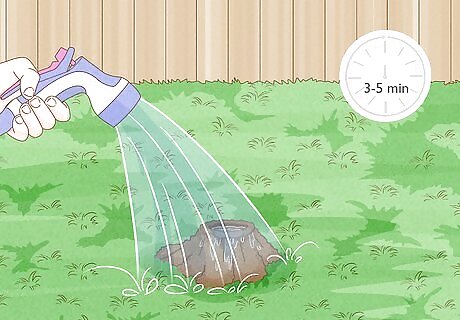
Soak the ant hill with a garden hose for several minutes. Turn on your hose full blast and drench the ant hill and surrounding area for a good 3-5 minutes or more. Soak it until the ground is fully saturated and the water is ponding, and then keep going a bit longer. Ant hills can be 3 ft (0.91 m) deep, so you need to use a lot of water to flood the tunnels all the way to the bottom.
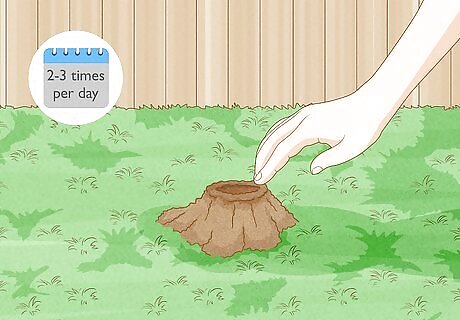
Check back for ant activity over the following 3 days. Check back on the hill 2 or 3 times per day. If you don’t see any activity after 3 days, the ants are probably all dead. Otherwise, either repeat the flooding or move on to other measures.
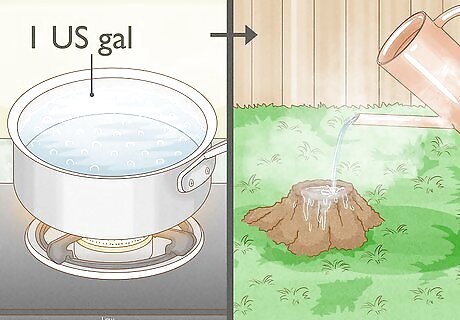
Boil 1 US gal (3.8 L) of water for the ant hill if you still see activity. If tepid water isn’t doing the job, try adding extreme heat to the equation. Boil a large pot of water on the stove, then very carefully transport it out to the ant hill. Slowly, steadily, and carefully pour it into the main opening of the ant hill. You may have better results if you boil 2-3 pots of water simultaneously, then pour them one after the other into the ant hill. The more water, the better! Check after a couple hours and over the next few days. If the ants are still alive, repeat the process or try something else.

Mix dish soap into the boiling water for possible added impact. Boil one or more large pots of water as before, then kill the heat and stir a few large squirts of dish soap into each pot. Pour the boiling soapy water into the ant hill, check for signs of life, and repeat as needed. While there isn’t clear scientific evidence to support it, it’s possible that adding soap will coat the ants in a slippery sheen that will make it impossible for them to function properly. This, mixed with the torrent of boiling water, may just do the trick!

Pour 1 US qt (0.95 L)-plus of vinegar into the hill as an alternative. The acidity of the vinegar may kill the ants that are soaked by it, if they don’t drown anyway. The more vinegar you use the better, so consider dumping 1 US gal (3.8 L) jugs of vinegar into the hill opening daily for 3 days. You may have even more success if you pour several scoops of baking soda into the hole first. The volcano-like foaming action caused by the combination of vinegar and baking soda may push the mixture deeper into the ant hill’s tunnels. It also looks cool erupting out of the ant hill!
Using Common Home and Garden Products

Sprinkle on cornmeal or baking soda as an easy option. Apply a nice coating of either item on both the hill and the surrounding area. The ants will hopefully eat the cornmeal or baking soda, but not be able to digest it. Instead, it will soak up the moisture inside them and expand until it kills them. There isn’t a lot of scientific evidence to support either of these, but lots of people swear by one or the other. Also, they’re not harmful to your lawn or pets.
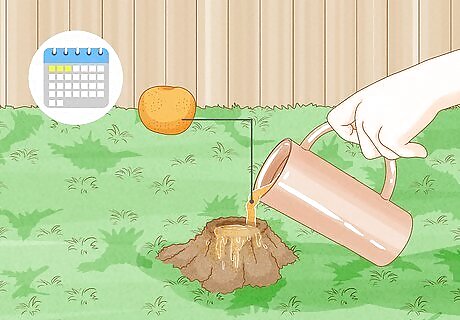
Spread an orange rind smoothie around the hill as a fragrant option. Mix the rinds of at least 3-4 oranges in a blender, and add a bit of juice if needed to create a smoothie texture. Pour the mixture around the perimeter of the hill and on top of it as well. Repeat this daily for at least 3 days. Ants supposedly hate the scent of citrus oils, so the hope here is that they’ll be so upset with the citrusy goop that they’ll move somewhere else. Support for this method is primarily anecdotal rather than scientific.
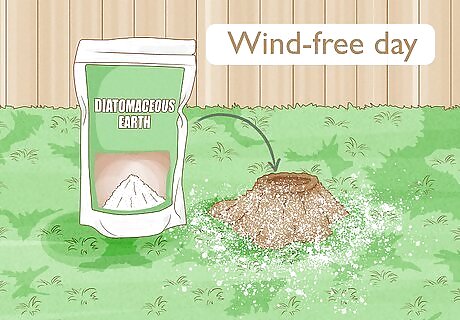
Apply diatomaceous earth as an option on a wind-free day. Pour a fair amount of the granules around and on top of the ant hill. Diatomaceous earth is essentially the crunched-up exoskeletons of a type of algae. The tiny, sharp granules are uncomfortable or even dangerous for ants to walk on, and if they eat any of it, it will cause fatal internal injuries. Diatomaceous earth will irritate your skin and can cause quite a bit of discomfort if it gets into your eyes or breathing passages. Only apply it on a wind-free day, and consider wearing eye and breathing protection when using it.
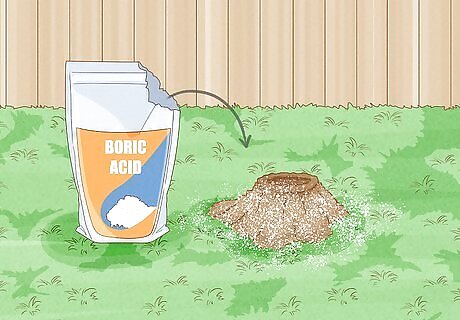
Use boric acid, with caution, if other options have failed. You can sprinkle powdered boric acid around and on the ant hill, or put several scoopfuls into 1 US gal (3.8 L) of water and pour it into the ant hill. Boric acid is toxic to ants if they consume it, so the hope here is that the workers will bring it back for the other ants—including the queen—to eat. However, boric acid will also kill any grass in the immediate area, and it is also dangerous to use if pets or kids frequent the area.
Applying Chemical Ant-Killers
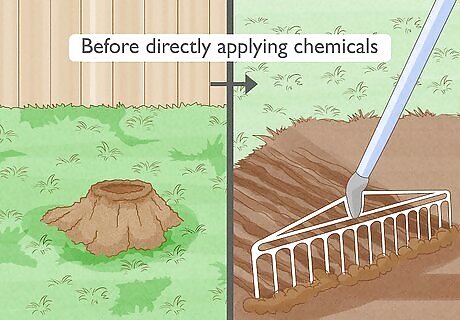
Flatten the hill and loosen the soil before directly applying chemicals. If you want to directly apply a poison to the ant hill, start by flattening out the hill. Use your rake to loosen up the soil so that you can blend the chemical into the dirt.
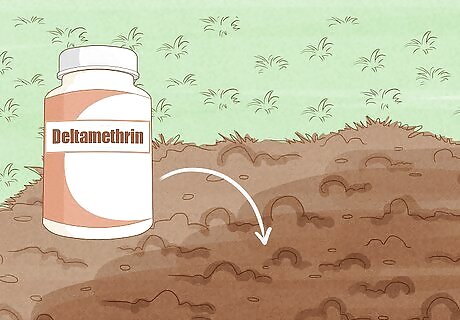
Apply your chosen chemical insecticide as instructed on the package. Add the recommended amount of granulated or liquid ant-killer to the loosened soil. Effective ant-killing chemicals include: Deltamethrin Bendiocarb Bifenthrin Diazinon Carbaryl (e.g., Sevin brand)
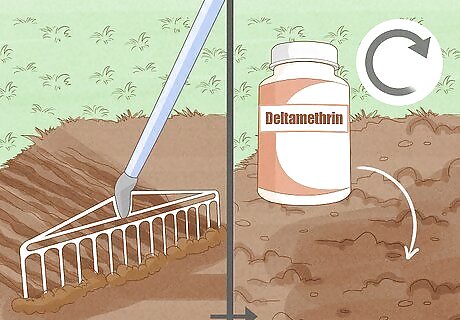
Rake the insecticide into the soil and repeat as needed. Mix the chemical thoroughly into the soil. When the ants inevitably rebuild the top of the hill, they’ll get coated in the poison and carry it deeper into the colony. In less than a week, there’s a good chance that all the ants will be dead. Follow the reapplication instructions included with your chosen insecticide, if necessary.
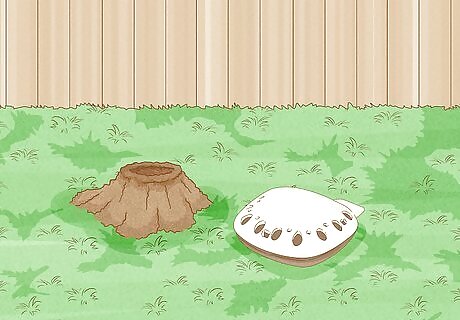
Use bait traps instead, if you don’t want to disturb the ant hill. If you’re looking for the simplest chemical ant-killer option, simply buy several enclosed ant bait traps marketed for outdoor use. Place them around the perimeter of the ant hill, and the worker ants will enter, take the poisoned food into the colony, and kill most if not all of the ants inside. Enclosed bait traps make it harder for pets or kids to access the poison, but they aren’t completely foolproof. Supervise any pets or kids closely or, better yet, keep them out of the area. It will probably take less than a week for the ant colony to be poisoned and killed off. You can buy these traps and other insecticides at home improvement stores.
Destroying Ant Hills Manually
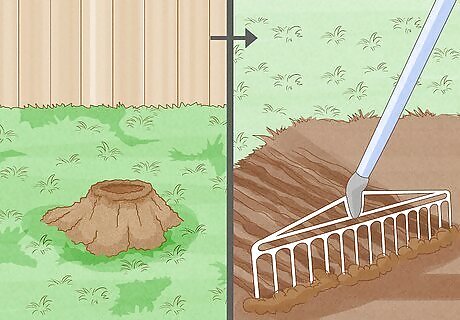
Flatten out the hill with a rake or shovel. For smaller hills, you can even just use your foot to knock over and tamp down the ant hill. While this is the simplest solution, keep in mind that it’s almost certainly only a temporary one. It’s probably best saved for when you’re trying to make your yard look a little better for a few hours for a garden party or family picnic. Like an iceberg, the vast majority of an ant colony is beneath the surface, so you’ll be doing very little overall damage to their home this way.

Keep flattening out the hill when it reappears. Within a couple days or maybe even several hours after you’ve flattened out the hill, the ants will likely have reconstructed it. If you’re intent on destroying the hill with nothing more than manual power, keep flattening out the hill every time it reappears. If you’re lucky, the ants will eventually give in and relocate. This works occasionally to get rid of an ant hill permanently, but don’t count on it—ants are very persistent!

Dig down to the bottom of the colony, then refill the hole. If you’re tired of superficial destruction, take your shovel and start excavating the ant colony. Keep digging until you don’t see any more tunnels or other evidence of ant activity. Then, fill the hole back in with the soil. After this amount of disruption and destruction, the ants may choose to move elsewhere. You might also manage to kill the queen this way, in which case the colony will die off in disarray. Be prepared to dig deep—ants often tunnel down 3 ft (0.91 m), and the colony can be several feet/meters in diameter as well. So you’ll end up digging up quite a bit of your yard!


















Comments
0 comment